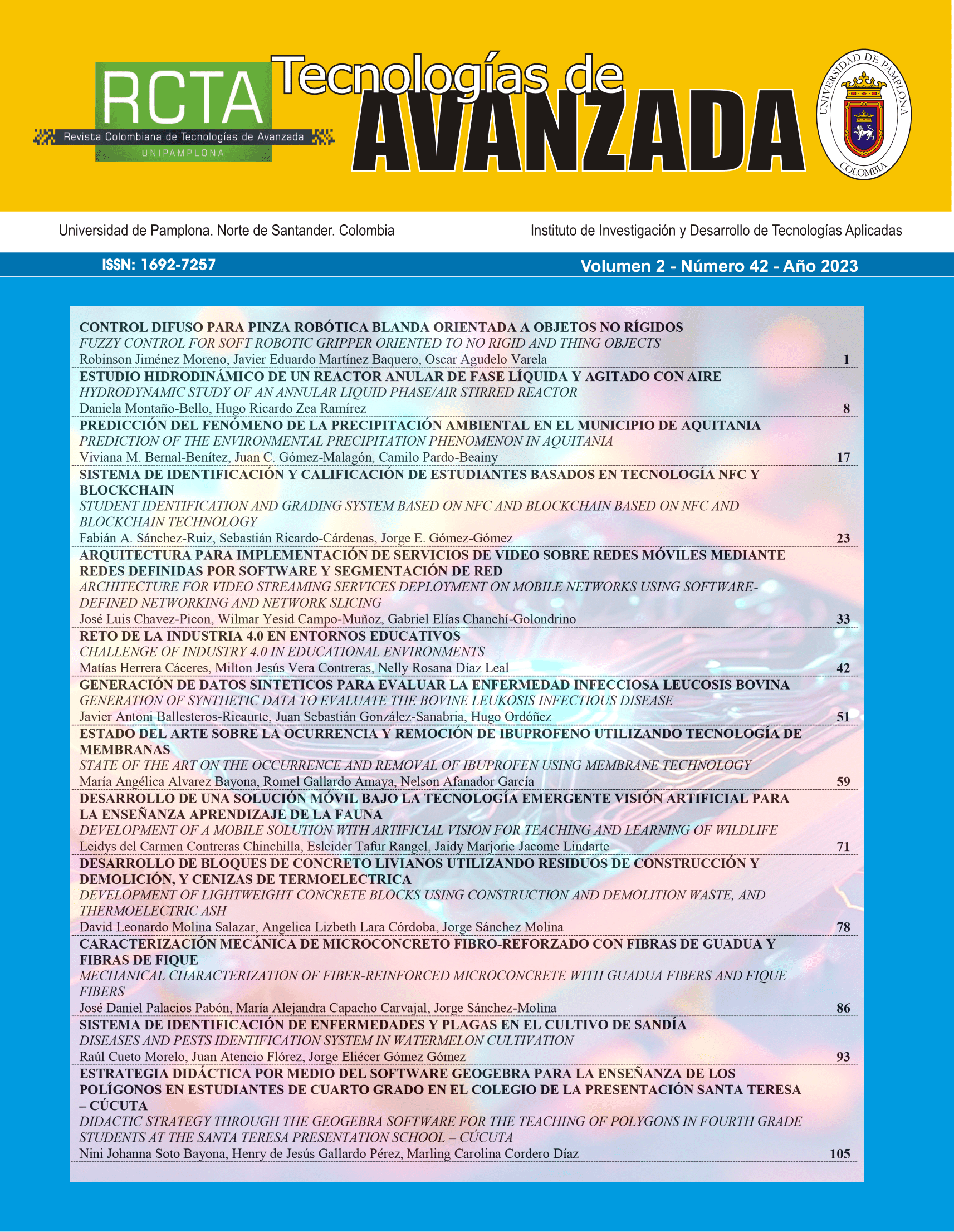Beneficios de la utilización de ceniza de moringa oleifera como materia prima en la fabricación de materiales cerámicos de construcción
DOI:
https://doi.org/10.24054/rcta.v2i42.2761Palabras clave:
Proceso cerámico, fundentes, vitrificación, material sustituto, caracterización mineralógicaResumen
La finalidad del presente trabajo ha sido explorar si resulta beneficioso el uso de la ceniza de la moringa como material sustituto de arcilla en la fabricación de cerámicos para mampostería. Para ello se conformaron pastas cerámicas con 0%, 4,5% y 9,0% de ceniza, las cuales fueron humectadas y posteriormente sometidas a proceso de moldeo mediante la técnica de extrusión. Luego de un proceso de secado natural de las probetas se realizó cocción de estas a 800°C, 900°C y 1000°C en un horno de calentamiento con resistencia eléctrica. El proceso de investigación incluyó la caracterización de las materias primas mediante técnicas como la difracción y la fluorescencia de rayos X (DRX/FRX), así como espectroscopia de infrarrojos con transformada de Fourier (FTIR). La caracterización del producto terminado se realizó mediante análisis físico-cerámico asociado a cambios dimensionales en el material, porosidad abierta, así como caracterización mediante microscopia electrónica de barrido (SEM) y DRX. Los resultados obtenidos dejan ver que la ceniza de moringa es químicamente rica en potasio (26,29%) y calcio (26,03%) con una cantidad importante de azufre (3,15%) y cloro (2,20%) estando presente estos elementos tanto en fracción amorfa (80,1%) como cristalina (calcita, arcanita y silvita). Con relación a los cerámicos obtenidos se identificó que la adición de moringa favorece los procesos de sinterización y vitrificación de mejor manera respecto a la formulación con solo arcilla, esto a medida que se incrementa la temperatura de cocción y a pesar de la existencia de fases carbonatos y materia orgánica residual en la ceniza. Se logra obtener un cerámico 11% menos pesado que el material de referencia.
Descargas
Referencias
Abdull, A., Ibrahim, M., & Kntayya, S. (2014). Health benefits of Moringa oleifera. Asian Pacific Journal of Cancer Prevention, 15(20), 8571-8576. [En línea]. Disponible en: https://www.koreascience.or.kr/article/JAKO201435648479194.pdf
Mahmood, K., Mugal, T., & Haq, I. (2010). Moringa oleifera: A natural gift - A review. Journal of Pharmaceutical Sciences and Research, 2(11), 775. [En línea]. Disponible en: http://citeseerx.ist.psu.edu/viewdoc/download?doi=10.1.1.193.7882&rep=rep1&type=pdf
Bonal, R., Rivera, R., & Bolívar, M. (2012). Moringa oleifera: Una opción saludable para el bienestar. Medisan, 16(10), 1596-1599. [En línea]. Disponible en: https://www.redalyc.org/pdf/3684/368448459014.pdf
Martín, C., Martín, G., García, A., Fernández, T., Hernández, E., & Puls, J. (2013). Potenciales aplicaciones de Moringa oleifera. Una revisión crítica. Pastos y Forrajes, 36(2), 137-149. [En línea]. Disponible en: https://www.redalyc.org/pdf/2691/269129327001.pdf
Doménech, G., Durango, A., & Ros, G. (2017). Moringa oleifera: Revisión sobre aplicaciones y usos en alimentos. Archivos Latinoamericanos de Nutrición, 67(2), 86-97. [En línea]. Disponible en: https://www.proquest.com/openview/286a37f1993a0a45eea72086f814dd84/1?pq-origsite=gscholar&cbl=2032499
González, F. (2018). Un estudio transversal de Moringa oleifera Lam. (Moringaceae). Dominguezia, 34(1), 5-25. [En línea]. Disponible en: https://pesquisa.bvsalud.org/portal/resource/pt/biblio-1005187
Castro, A. (2013). El árbol Moringa (Moringa oleifera Lam.): Una alternativa renovable para el desarrollo de los sectores económicos y ambientales de Colombia. Universidad Militar Nueva Granada. [En línea]. Disponible en: https://repository.unimilitar.edu.co/bitstream/handle/10654/10956/Plantaciones%20de%20moringa%20en%20Colombia.pdf?sequence=2&isAllowed=y
Gelves, J., Rozo, S., Monroy, R., & Romero, Y. (2021). Árboles de la zona metropolitana de Cúcuta: Una aproximación de la cantidad de especímenes presentes. San José de Cúcuta, Colombia: Editorial Universidad Libre seccional Cúcuta.
Navarro, G. (2015). Moringa oleífera: Un aliado en la lucha contra la desnutrición. Acción Contra el Hambre: ACF International. Madrid. [En línea]. Disponible en: https://www.accioncontraelhambre.org/sites/default/files/documents/moringa-final-pag-simples.pdf
Flórez, A., Sánchez, J., & Blanco, D. (2018). Las arcillas de las formaciones geológicas de un área metropolitana, su uso en la industria cerámica e impacto en la economía regional. Revista EIA, 15(30), 133-150. [En línea]. Disponible en: https://doi.org/10.24050/reia.v15i30.1219
ASTM International. (2003). Standard test method for drying and firing shrinkages of ceramic whiteware clays. ASTM C326-03. American Society for Testing and Materials.
Instituto Colombiano de Normas Técnicas y Certificación (ICONTEC). (2005). Baldosas cerámicas. Parte 3. Método de ensayo para determinar la absorción de agua, porosidad aparente, densidad relativa aparente y densidad aparente. NTC 4321-3.
Chukanov, N. (2013). Infrared spectra of mineral species: extended library. Springer Science & Business Media. [En línea]. Disponible en: https://media.hugendubel.de/shop/coverscans/219PDF/21977400_lprob_1.pdf
Fernández, M. (2000). Manual sobre fabricación de baldosas, tejas y ladrillos. Beralmar SA, Terrassa. Laboratorio Técnico Cerámico S.L. [En línea]. Disponible en: https://datos.bne.es/obra/XX2949843.html
Garcés, L., & Hernández, M. (2004). La lluvia ácida: un fenómeno fisicoquímico de ocurrencia local. Revista Lasallista de Investigación, 1(2), 67-72. [En línea]. Disponible en: http://repository.unilasallista.edu.co/dspace/handle/10567/190
Cáceres, V., Molina, J., & García, A. (2015). Development and validation of an analytical method for the extraction and quantification of soluble sulfates in red clay. Ceramica, 61, 277-284. https://doi.org/10.1590/0366-69132015613591924
Gazulla, M., Gómez, M., Orduña, M., Vicente, S., & Arorós, J. (2010). Determinación de sales solubles y eflorescencias en tejas cerámicas. Boletín de la sociedad española de cerámica y vidrio, 49(3). [En línea]. Disponible en: http://boletines.secv.es/upload/20100527124506.201049189.pdf
Verduch, A. (1974). El empleo del cuarzo en las composiciones de cerámica blanca. Boletín de la Sociedad Española de Cerámica y Vidrio, 13(5), 409-418. [En línea]. Disponible en: https://dialnet.unirioja.es/servlet/articulo?codigo=7600166
Álvarez, D., Sánchez, J., & Gelves, J. (2017). Influence of raw materials and forming technique in the manufacture of stoneware ceramic. Ingeniería y competitividad, 19(2), 93-105. https://www.redalyc.org/articulo.oa?id=291354828009
Descargas
Publicado
Número
Sección
Licencia
Derechos de autor 2023 COLOMBIAN JOURNAL OF ADVANCED TECHNOLOGIES

Esta obra está bajo una licencia internacional Creative Commons Atribución-NoComercial 4.0.











